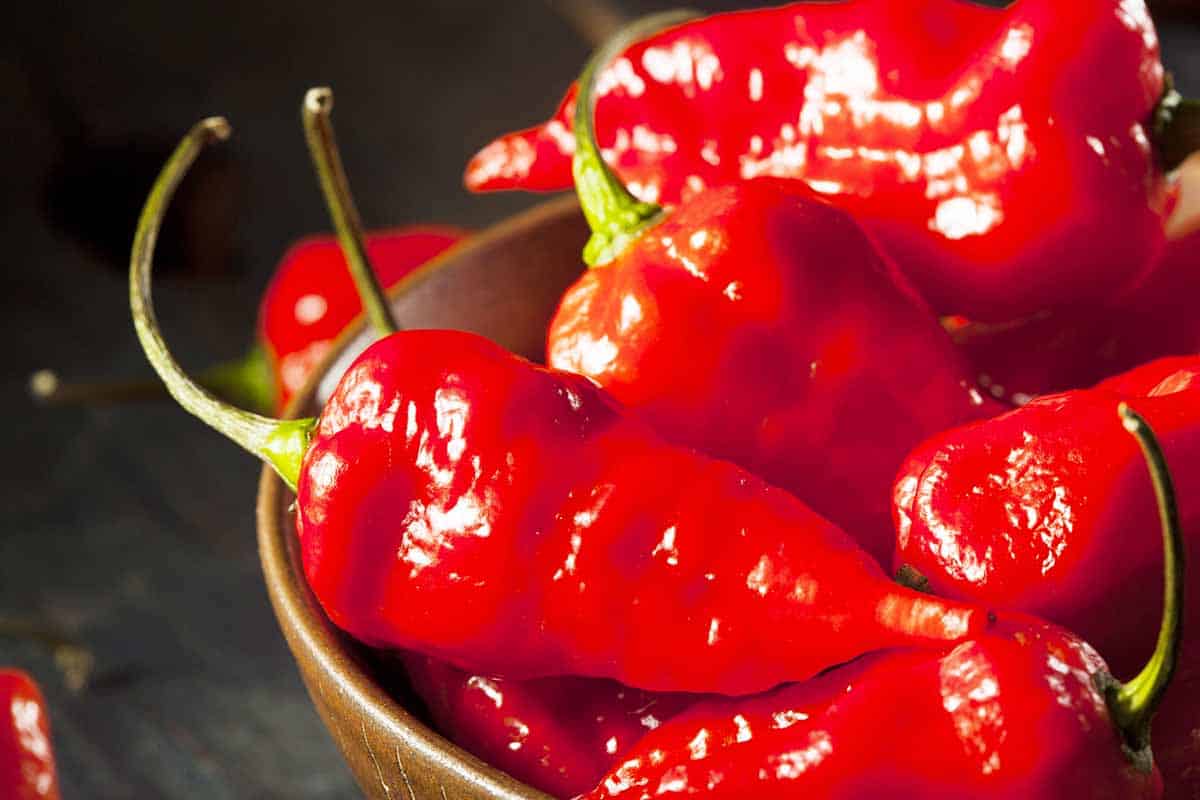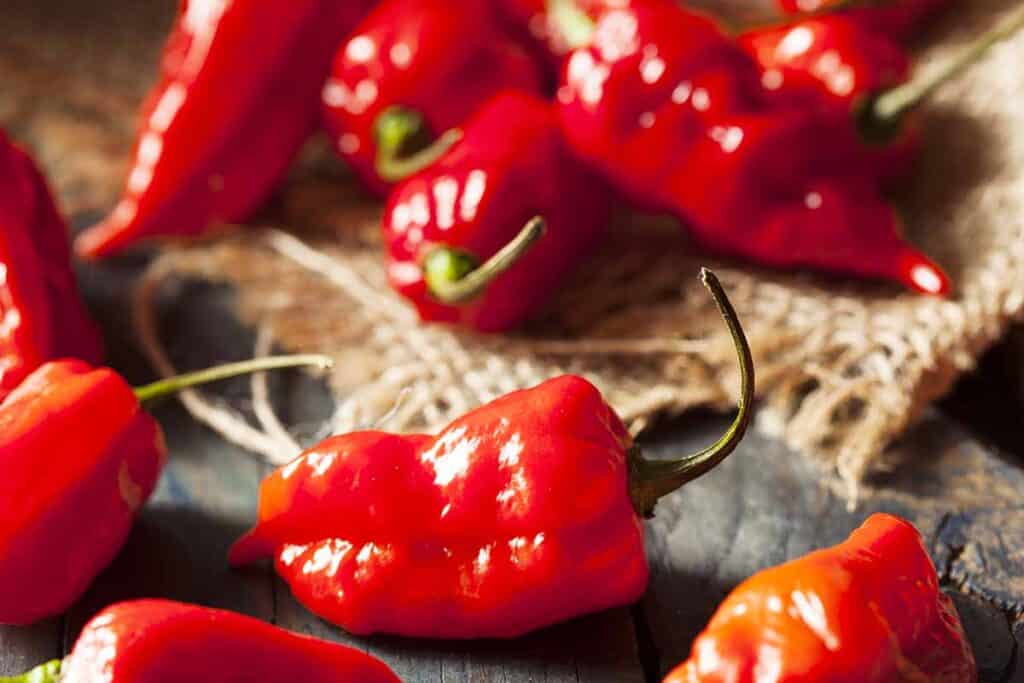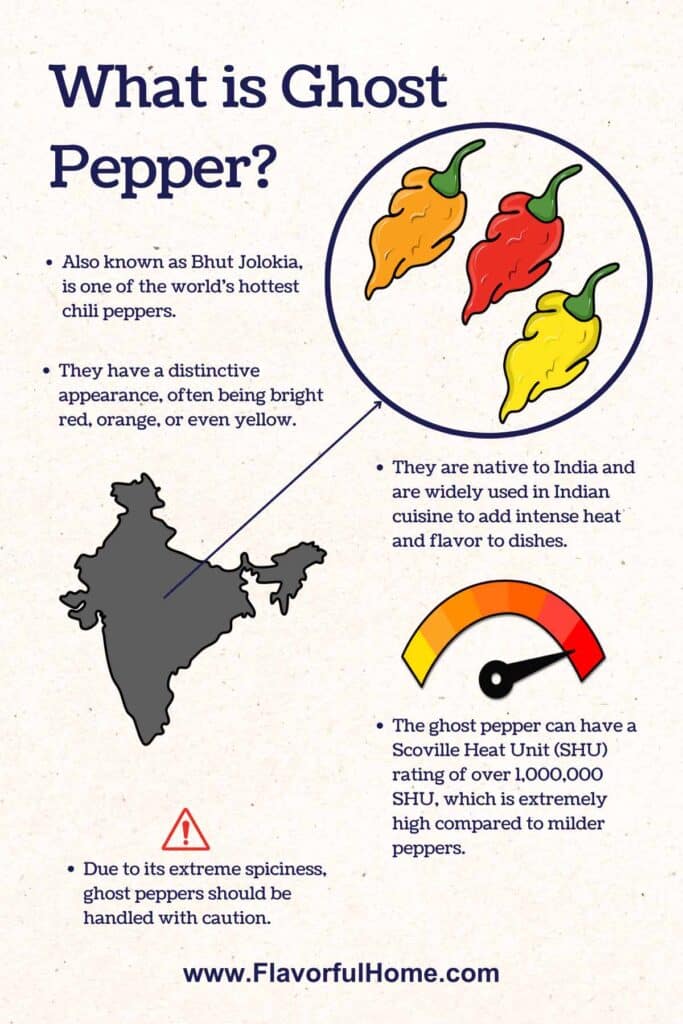The Ghost Pepper stands as one of the hottest chili peppers in existence. In this article, we embark on a journey to uncover the secrets and mysteries behind this fiery marvel.
If you want to add heat to your recipes, look no further. This pepper is incredibly hot and will surely make your recipes fiery.

The Ghost Pepper is also known as Bhut Jolokia. It is an extremely hot chili pepper that gained worldwide attention.
This hybrid chili pepper is native to Northeast India.
This chili pepper grows particularly in Assam, Nagaland, and Manipur.
Home cooks and professional chefs use these peppers to add a fiery kick to various recipes.
People usually add them to salsas, hot sauces, curries, pickles, and marinades.
Ghost Pepper infusion is also a thing. Snacks, chocolates, and cocktails infused with this pepper have become popular.
Bhut Jolokia is a popular choice for spicy food challenges and eating competitions. Participants attempt to consume large amounts of foods infused with these peppers.
Some even eat the peppers themselves within a limited time frame. These challenges test the endurance and tolerance of contestants.
Pepper breeders use this pepper as a parent plant to create even hotter chili peppers. This pepper is a key to developing peppers like the Carolina Reaper and Pepper X.
Note that direct contact with the pepper can cause skin irritation. You can even suffer from burns if you handle them carelessly. For this reason, you must exercise caution when consuming or handling Bhut Jolokia.
Ghost Pepper is one of the hottest peppers in the world.
The Ghost Pepper ranks around 1,000,000 on the Scoville Scale.
To better understand this heat, know that jalapeno peppers average around 8,000 SHU.
The intense heat of peppers comes from capsaicin. This compound is responsible for the spicy taste of pepper plants.
Bhut Jolokia has gained global recognition for its exceptional heat. In fact, the Guinness World Record hailed it as the hottest pepper from 2007-2011.
This recognition solidifies the Ghost Pepper’s status as a culinary sensation worldwide.

Ghost Pepper has a distinctive appearance that makes them different from other peppers.
One of its most noticeable characteristics is its wrinkled skin. This look adds to their unique charm.
This pepper has a textured surface. Deep creases cover it, giving it a bumpy and slightly crinkled appearance.
In addition to its wrinkled skin, it also boasts vibrant colors. Their hue further contributes to their visual appeal.
It can be red, orange, yellow, or even brown when fully ripe.
Its vivid colors make its appearance visually striking. For this reason, people also use it to add a touch of excitement to dishes.
It’s worth noting that the colors of Ghost Peppers can vary. These variations are especially evident as they ripen.
They start as pale green and gradually develop a deep color as they mature. The final color depends on the specific variety of the Pepper.

Ghost Peppers have notes of citrus, tropical fruits, and hints of earthiness.
This unique combination of flavors distinguishes this type from other types of chilies.
Since this pepper is extremely hot, balancing heat and flavor in your dishes is crucial.
Ghost Peppers taste fruity and slightly sweet. They are also also extremely hot!
The key lies in adding this pepper carefully to enhance dishes without overpowering them. You can create recipes with balanced flavors by carefully controlling your portion.
Indeed, this pepper offers a lot more than just extreme heat. Their complex flavor profile adds depth and flavor to recipes.
There are many places where you can find and buy this unique pepper. As its popularity increases, more stores, including online marketplaces, sell them.
Here are different places where you can purchase it:
Well-stocked supermarkets may carry these super hot peppers. You may find it in grocery stores, especially in areas with a diverse culinary scene.
Check the produce section first. You may inquire with the store manager if you don’t find the peppers there.
Some local farmers’ markets may offer specialty peppers, depending on your location.
Visit your nearest farmers’ market and look for vendors that sell hot peppers.
Specialty food stores that focus on international ingredients may offer Ghost Pepper.
These stores cater to culinary buffs and often have a wide selection of unique and exotic items.
You’re in luck if you live in or near a region where pepper cultivation is popular. You can purchase it directly from farms.
Take a trip to nearby farms or visit farmers’ associations to inquire.
Better yet, contact people growing these peppers to ask about purchasing options.
Various online marketplaces provide a convenient option for you to buy these peppers. For instance, Amazon and eBay offer fresh, dried, or powdered Ghost Pepper.
They may also offer seeds, hot sauces, or spice blends.
The versatility of Ghost Pepper allows them to complement a wide range of cuisines.
Here are a few examples:
Ghost Pepper pairs well with the vibrant flavors of ingredients in Asian dishes. For instance, they lend heat to Thai dishes like this Ghost Pepper Chicken Curry.
In Sichuan cuisine, people use these peppers instead of Sichuan peppers in Mapo Tofu.
Ghost Pepper brings a fiery punch to traditional Mexican and Latin American dishes.
You will find them added to mole and empanadas. After all, their fruity flavor pairs with tomatoes, onions, and garlic.
The most popular hot pepper in Caribbean cuisine is the Scotch bonnet pepper. However, for people who want to take the heat up a notch, this pepper is a go-to alternative. It pairs well with beans, chickpeas, and other common ingredients in Caribbean dishes.
There are many ways to use Ghost Pepper in the kitchen. You can add them to dishes where you want heat and some fruity notes.
Here are some common culinary uses of Ghost Pepper:
Ghost Pepper gives salsas a fiery intensity. You can use them in traditional salsas with a tomato base. Add them to fruity salsas like pineapple or mango for an irresistible heat.
Ghost Pepper also finds its place in spicy curries. They lend searing heat and fruity undertones. You may include them in a Thai red curry or Indian vindaloo for some complexity and depth.
Hearty stews get a fiery punch from Ghost Pepper. They work well in most stews, including Chili con Carne and spicy Gumbo. The heat creates a warming dish that will surely satisfy your hunger.
You may add it to pickled vegetables for a spicy touch. In addition, you may also pickle the Ghost Peppers themselves. These pickles make a perfect side dish. They are also great in sandwiches and burgers.
A marinade with this spicy pepper infuses meats, poultry, and seafood with heat and flavor. The marinade penetrates the protein, creating flavorful dishes with a spicy punch.
For grilling and smoking, add Bhut Jolokia to your rubs. The combination of spices and the intense heat of the pepper adds flavor to meats and creates a crust. They make a delicious balance of smokiness and spice in your dish.
This is a crucial ingredient in creating a hot sauce. Chipotle Ghost Pepper and Habanero Ghost Pepper sauce add a pleasant kick to your dishes.
You may also infuse your oils and vinegar with these spicy peppers. This way, you can control the intensity of heat. These condiments provide a concentrated flavor to marinades, dressings, and sauces.
You may also add this spicy powder to your favorite spice blends. If your current mix lacks heat, Bhut Jolokia will compensate for that. Plus, it will also add a fruity undertone for more depth.
A sprinkle of Ghost Pepper powder can add excitement to everyday snacks. Use it to elevate your regular popcorn, nuts, and potato chips.
As mentioned, the Ghost Pepper is a potent ingredient you should handle cautiously. It also has an intense heat that can render a dish inedible if you use too much. For this reason, you must be careful when incorporating it into dishes.
Here are some useful tips for using it in cooking:
There are things you can do to ensure your safety while handling or cooking with these peppers. They’re easy to follow, and it is always best to err on the side of caution, especially in the kitchen.
It would be best to watch how much you put to prevent Ghost Peppers from overpowering your dishes. Don’t worry, though. There are easy ways to ensure that your recipes don’t end up extremely spicy.
At around 1,000,000 SHU, the Ghost Pepper is about 400 times hotter than a jalapeño pepper. It was the world’s hottest pepper in 2007. Their intense heat can be too much for individuals with low spice tolerance.
No. Ghost Peppers are among the spiciest chili peppers. However, they are not hotter than California Reapers. California Reaper is at around 2,000,000 SHU, two times hotter.
It’s also known as Bhut Jolokia Pepper, Naga Jolokia, and Bih Jolokia. People also call them Red Naga Chili, Raja Mirchi, and Ghost Chili.
The Ghost Pepper is an incredibly hot chili pepper. It is a favorite among chili enthusiasts and adventurous eaters. The Ghost Pepper’s wrinkled skin and vibrant colors add appeal to recipes.
Beyond its heat, the Ghost Pepper offers a complex flavor profile. It has fruity and slightly sweet notes. Whether you add it to hot sauces, salsas, pickles, or snacks, Ghost Peppers bring a punch and depth of flavor.





